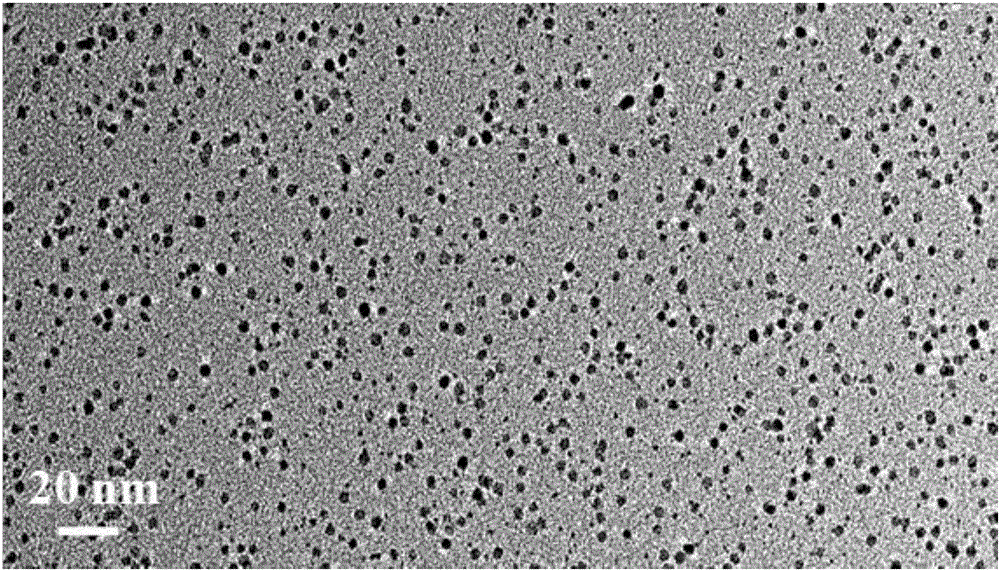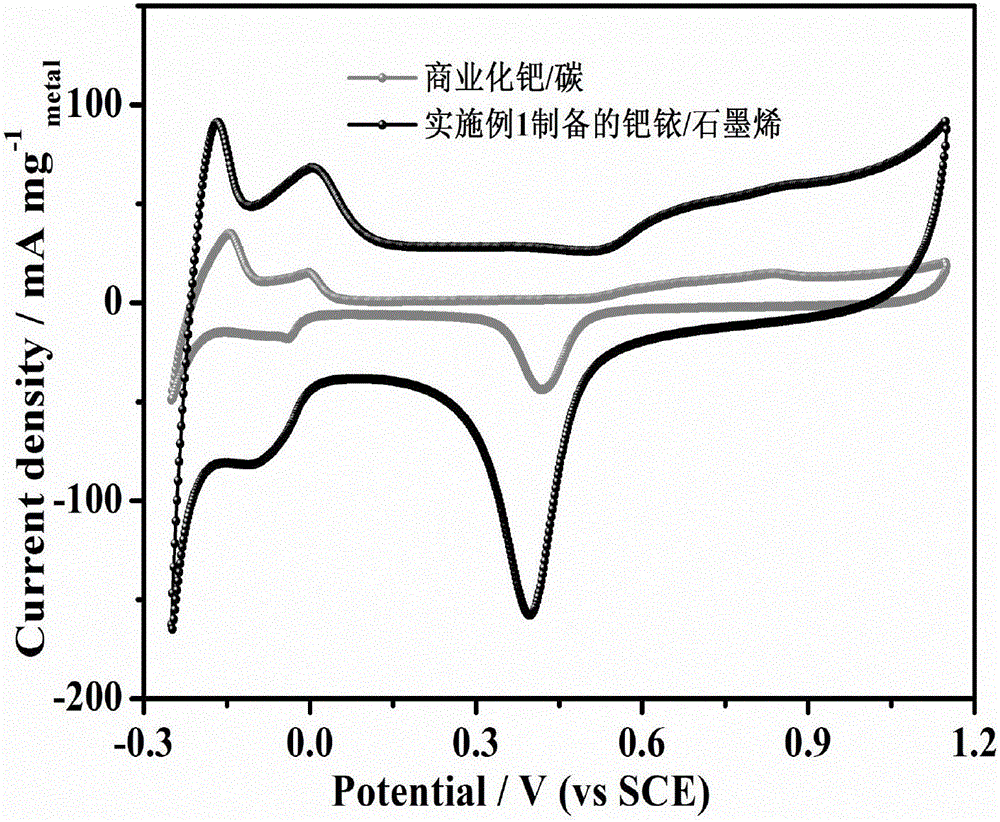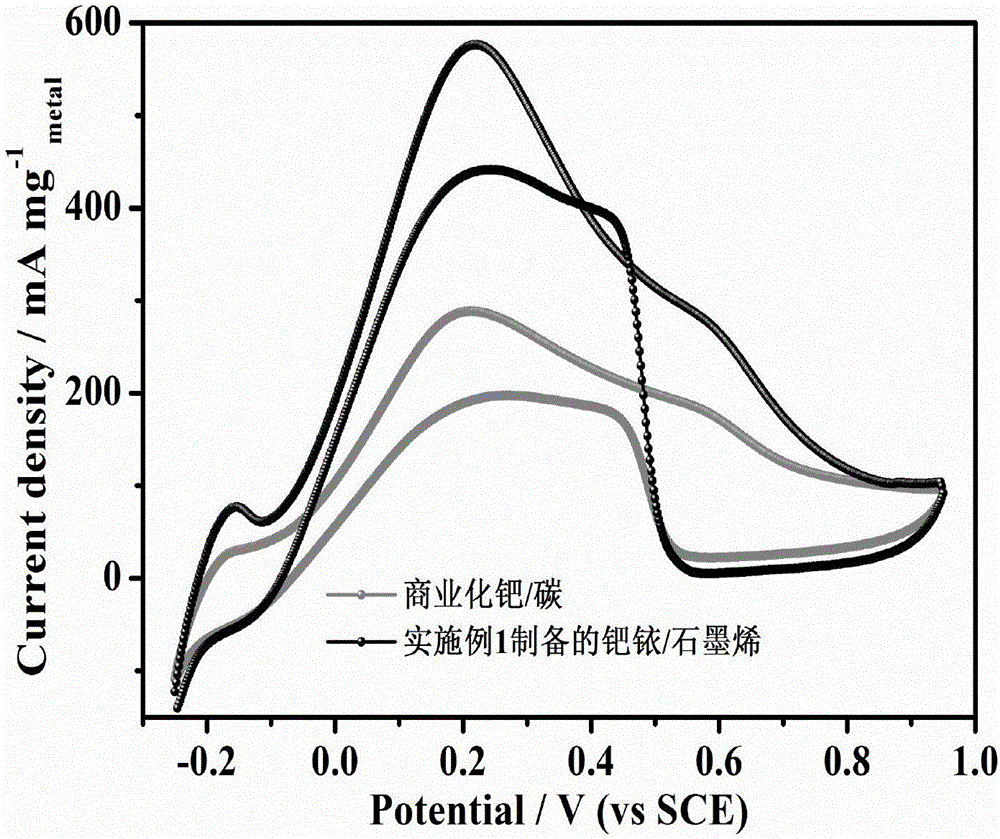Method for preparing graphene-supported palladium-iridium nano-particle catalysts and formic acid oxidation electrocatalysis application of graphene-supported palladium-iridium nano-particle catalysts
A nanoparticle, graphene technology, applied in catalyst activation/preparation, chemical instruments and methods, physical/chemical process catalysts, etc., can solve problems such as difficulty in removal, environmental pollution and safety hazards, and inability to fully exert catalytic performance, and achieve operational Simple, high practical value, wide application range and promising effect
- Summary
- Abstract
- Description
- Claims
- Application Information
AI Technical Summary
Problems solved by technology
Method used
Image
Examples
Embodiment 1
[0038] The preparation method of the palladium iridium / graphene high-performance formic acid oxidation catalyst of the present embodiment may further comprise the steps:
[0039] 1) Add 15mg of graphene to 8mL of formic acid solution and mix uniformly by ultrasonic at 90°C, the ultrasonic power is 300W.
[0040] 2) 0.286mL chloroiridic acid (7mg·mL -1 Ir ) and 0.221mL sodium chloropalladate (20mg·mL -1 Pd ) the mixed solution prepared by ultrasonication for 1h, the ultrasonic power is 300W.
[0041] 3) Heat the solution homogeneously mixed in step 2) to 90°C.
[0042] 4) Rapidly inject the mixed solution in step 3) into the mixed solution of graphene and formic acid in step 1), and perform ultrasonic treatment for 5 hours under sealed conditions at 90° C., and the ultrasonic power is 300W.
[0043] 5) The product obtained by the reaction is washed and dried at 60° C. for 10 h, which is a palladium-iridium / graphene high-performance formic acid oxidation catalyst.
[0044]...
Embodiment 2
[0049] The preparation method of the palladium iridium / graphene high-performance formic acid oxidation catalyst of the present embodiment may further comprise the steps:
[0050] 1) Add 15 mg of graphene to 5 mL of formic acid solution and mix uniformly by ultrasonic at 80° C., and the ultrasonic power is 300 W.
[0051] 2) 0.286mL chloroiridic acid (7mg·mL -1 Ir ) and 0.221mL sodium chloropalladate (20mg·mL -1 Pd ) the mixed solution prepared by ultrasonication for 2h, the ultrasonic power is 500W.
[0052] 3) Heat the solution homogeneously mixed in step 2) to 80°C.
[0053] 4) Rapidly inject the mixed solution in step 3) into the mixed solution of graphene and formic acid in step 1), and perform ultrasonic treatment for 8 hours under sealed conditions at 80° C., with an ultrasonic power of 500 W.
[0054] 5) The product obtained by the reaction is washed and dried at 80° C. for 16 hours, which is a palladium-iridium / graphene high-performance formic acid oxidation catal...
Embodiment 3
[0060] The preparation method of the palladium iridium / graphene formic acid oxidation catalyst of the present embodiment may further comprise the steps:
[0061] 1) Add 15 mg of graphene to 8 mL of sodium borohydride aqueous solution (2 mg / mL) and mix uniformly by ultrasonic at 90° C. with an ultrasonic power of 300 W.
[0062] 2) 0.286mL chloroiridic acid (7mg·mL -1 Ir ) and 0.221mL sodium chloropalladate (20mg·mL -1 Pd ) the mixed solution prepared by ultrasonication for 1h, the ultrasonic power is 300W.
[0063] 3) Heat the solution homogeneously mixed in step 2) to 90°C.
[0064] 4) Rapidly inject the mixed solution in step 3) into the mixed solution of graphene and sodium borohydride in step 1), and perform ultrasonic treatment for 5 hours under sealed conditions at 90° C., and the ultrasonic power is 300W.
[0065] 5) The product obtained by the reaction is washed and dried at 60° C. for 10 h, which is the palladium iridium / graphene-1 formic acid oxidation catalyst....
PUM
| Property | Measurement | Unit |
|---|---|---|
| concentration | aaaaa | aaaaa |
Abstract
Description
Claims
Application Information
 Login to View More
Login to View More - R&D
- Intellectual Property
- Life Sciences
- Materials
- Tech Scout
- Unparalleled Data Quality
- Higher Quality Content
- 60% Fewer Hallucinations
Browse by: Latest US Patents, China's latest patents, Technical Efficacy Thesaurus, Application Domain, Technology Topic, Popular Technical Reports.
© 2025 PatSnap. All rights reserved.Legal|Privacy policy|Modern Slavery Act Transparency Statement|Sitemap|About US| Contact US: help@patsnap.com



